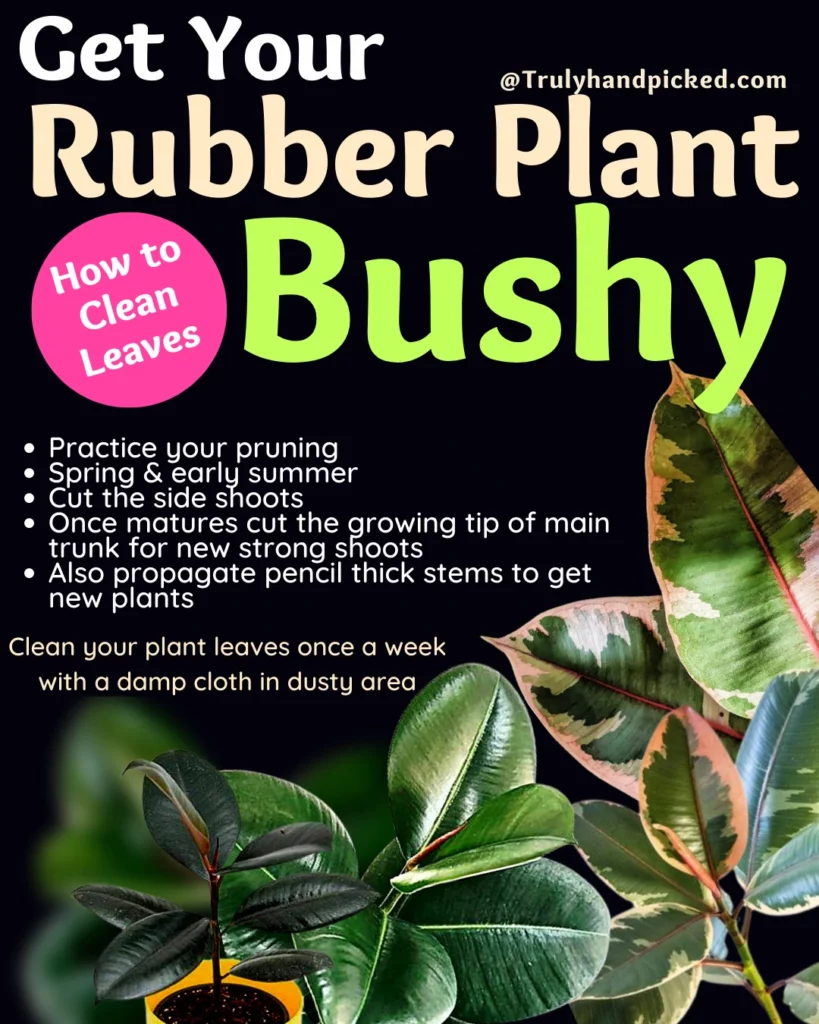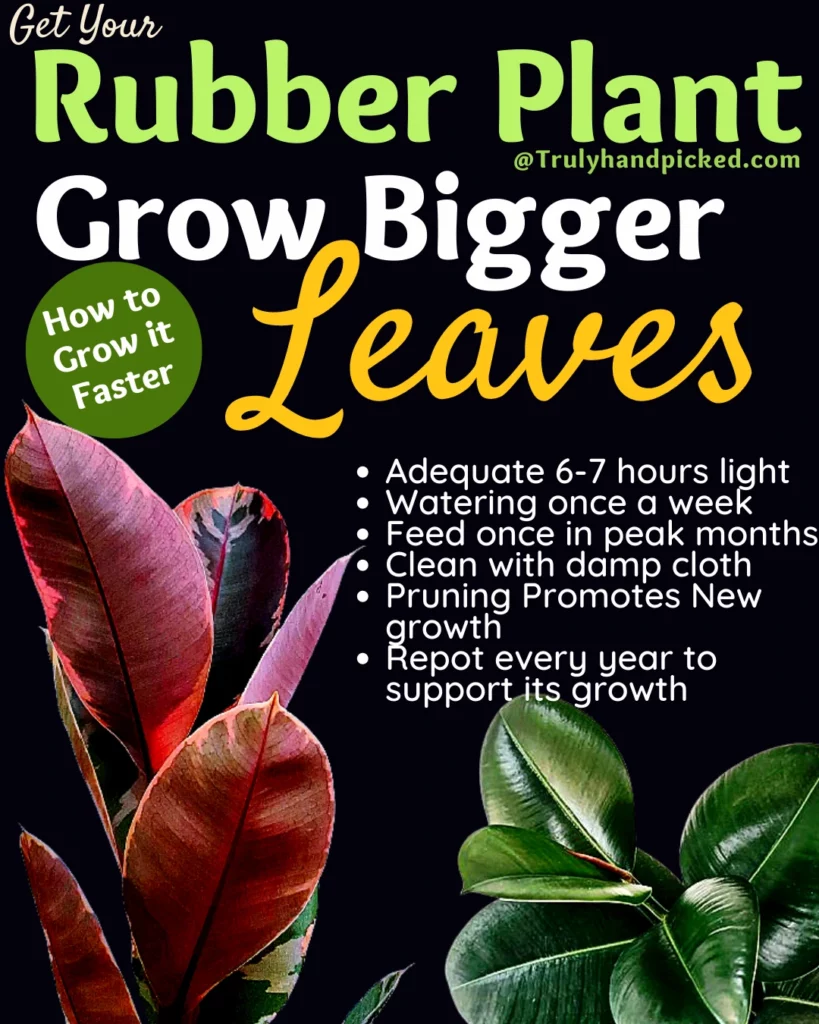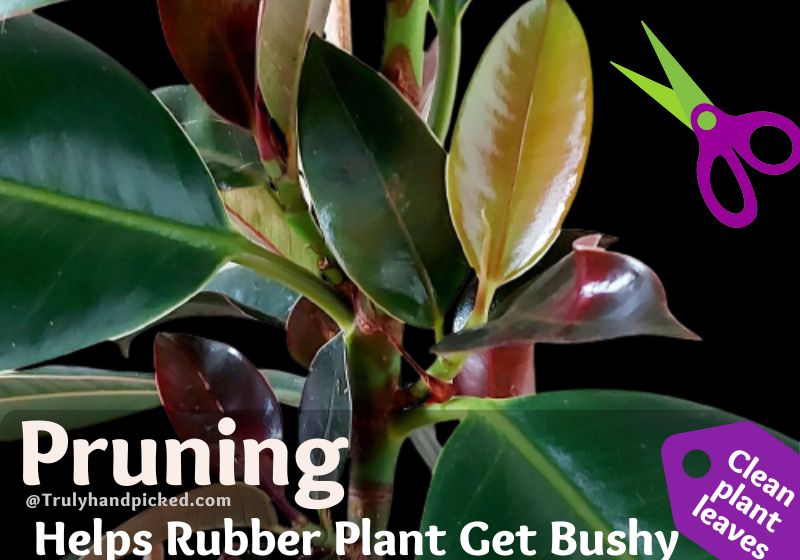Rubber plants are one of the popular ornamental houseplants for their big-foliage appearance. This quick-grower plant needs only some basic growing rudiments, which are totally effortless for a gardener to put up.
These sorts of ornamental plants always seem attractive with their vigorous form. To grasp that, you must bring out their best appearance through shiny, big leaves and with bright fuller conditions.
Make your Rubber Plant Grow Faster: 1. Adequate 6-7 hours of light 2. Watering once a week 3. Feed once in peak months 4. Clean with a damp cloth 5. Pruning Promotes New Growth 6. Repot every year to support its growth
So, here we suggest you the best useful tips on how to get that form naturally out of your growing rubber plant-
How To Make Rubber Plants Grow Faster?
Generally, rubber plants can grow up to 6-10 feet tall with full maturity. It has a fast-growing rate of around 2-3 feet per year.
But sometimes, the rate gets decreases and your plant may grow smaller than you expect. On the contrary, it can surpass the normal growth rate sometimes and can grow bigger beyond your expectation.
If you want to steal that faster-growing form out of your in-house rubber plant, try to fulfill its basic requirements sufficiently. Let’s see how to do it properly-
Get Your Plant Bright indirect light:
- Place the pot of your rubber plant where it can get bright but indirect light
- Make sure you provide the plant sun with partial shade to let it thrive
- A rubber plant should get 6-8 hours of bright sunlight every day
Water sufficiently (Hydrate when soil is dry):
- Consider a good watering habit for your growing rubber plant
- Water your plant when the top surface of the soil turns completely dry
- Make sure the potting mix and the pot both have the best draining quality
Nutrify Perfectly:
- Rubber plants are the moderate feeder thus, you have to feed them once a month during the peak seasons
- Make the soil fully fertile during the sowing and feed your plant with a balanced fertilizer
- Dilute the fertilizer with half of its strength before applying
Provide Enough Space:
- Give your plant a planter with good space for the roots and the stem
- The pot should be wide open and 1-2 sizes bigger than the root ball
- Repot your plant annually and don’t congest the around area of your plant to give it the best available space to thrive
Protect From Direct Sunlight:
- Finally, never put your plant under direct sunlight or no full sun exposure
- Pull your plant back from open windows with sheer curtains or cover, especially during winter
- And maintain a room temperature between about 60°-65° F to the best growing condition.
Related Links on Growing Bigger and Bushy Plants
Why My Aglaonema Leaves Are Curling
Growing My Philodendron Faster Bigger

How To Make Rubber Plants Bushy?
The rubber plant holds a large bonsai resemblance. Consequently, it eternally seems beautiful when the plant stays bushy and fuller. There are some basic tips too about how to hold the bushiest form of a growing rubber plant everlastingly.
The best way to keep a rubber plant bushy is through its proper and accurate pruning session. Let’s learn how it should be-
- Let the stems reach a height of about 20-24 inches long before starting your pruning session
- Once your find that the branches have enough leaves and the side branches has 2-3 leaves, you can cut them off
- Try to cut them above the nods and pinch off each stem attentively after cutting them off
- Practice your pruning session during spring to early summer and start it once the winter passes completely
- Cut the side shoots at their tender age to encourage them to grow in more quantity
- You can trim the leggy parts of a rubber plant for more than one year, as it is an excellent way to achieve the bushier form of your plant more easily
- Once you find that your rubber plant is about the touch the ceiling, cut it out from the middle of the top of your main plant
- You can cut the growing tip of the plant out of the main trunk to encourage the new solid branches at the leaf nods
- You can also propagate the plant from the pencil-thick stems of rubber plants, as propagating allows the lively trimmed branches to reuse again in the smarter way
- Don’t forget to take extra care of your rubber plant after the pruning, as they become vulnerable at that time (regular visits, feed, weed, water rotation for sunlight).
How To Make Rubber Plant Leaves Bigger?
Ficus elastica or rubber plants always appear attractive with their signature foliage that is big and radiant. No matter how glossy your rubber plant leaves are, they must grow at their adequate size to appear appealing.
Unfortunately, some of the rubber trees sometimes produce thinner or weaker foliage. It can hit your plant due to the unavailability of its fundamental growing essentials. Such as light, water, poor soil, or pests attack. To bring the healthiest foliage form out of your plant, you must provide it with these elementary necessities perfectly. Here are some quick tips in this regard on how to get the bigger leaves on your Ficus elastica plant naturally-
Follow A Proper Watering Schedule:
- Find the exact balanced amount of watering between overwatering and underwatering
- Apply the intensity of watering once a week or make the schedule depending on the weather
- Water your rubber plants once a week (depending on season and humidity), or wait until the top few inches turn dry.
Provide Them with Enough Sunlight:
- Supply your plant with bright but indirect sunlight consistently throughout its entire growing session
- Keep the planter away from open windows but make sure it can grab enough bright light per day
- Direct sunlight can burn your leaves, so bright indirect light for 6-7 hours will be enough.
Avoid Poor Soil:
- Make the soil fertile and rich in well-drained quality during the plantation
- Never pick a clay-base soil with poor nutrient quality to get the big foliage from a rubber plant
- Nutrient-rich soil mixed with coarse medium (sand, barks, perlite, etc..) to keep it breathing and not soggy
Keep Your Plant Insects Free:
- Due to being succulent, rubber plants are prone to hungry pests and bugs
- Try to keep your plant away from their infestation with natural remedies
- Poor lighting could make it easy for the pest to infest.
- Use neem oil and Garden soap spray over and under the leaves
- Check your rubber plants once a week to clean and wipe the leaves for a healthy lasting plant
Be Attentive To Their Needs:
- Be optimal about the needs of your growing rubber plant and try to fulfill them accordingly
- Never let your plant wait for any need for long or keep its desire of basic requirements unsatisfied ever
Stay Consistent (avoid overcaring /leaving uncared):
- Also, try to be attentive and consistent with the supply of your plant’s needs (feed, sunlight, and water)
- Remember that irregular or erratic caring is worse than an uncared regimen
So, never stay casual or inattentive towards your growing Ficus elastica ever, if you want to steal the vigorous form out of it innately.
How To Make Rubber Plant Leaves Shiny And Clean?
Besides, providing your plant is an essential requirement, there is one more way to increase the natural shine of the succulent leaves of a rubber plant noticeably. That is as follows-
Supplies You Will Need:
- A piece of sponge
- A piece of cloth
- 1 tbsp liquid detergent soap
- A bowl
- 1 cup of clean water
How To Practice:
- Combine the mild liquid detergent into the bowl of water and give them a good mix
- Dip the sponge into that mix and squeeze a little before taking it out (feels like a damp cloth)
- Now hold a leaf of your rubber plant by keeping a hand beneath the leaf and wipe the top of the leaf with the wet sponge
- Give it a good wipe by repeating the wipes several times (gently) until real color of the leaf is seen
- Repeat the same process for the below portion of the leaf and apply it to the entire leaves of your plant one by one
- Try this process once a week if you live in a dusty area, otherwise, once a month is enough to keep the foliage of your rubber plant shiny and clean sufficiently as you desire.
Reference Sites
- University of Missouri Extension: How to Speed Up Houseplant Growth (https://extension.missouri.edu/news/how-to-speed-up-houseplant-growth-3289)
- University of Florida IFAS Extension: Pruning Houseplants (https://gardeningsolutions.ifas.ufl.edu/plants/houseplants/pruning-houseplants.html)
- The Spruce: How to Clean Houseplants (https://www.thespruce.com/cleaning-houseplants-1902835)
- Ficus Elastica (Rubber Plant) Care Guide – Costa Farms (https://www.costafarms.com/plants/ficus-elastica-rubber-plant)
FAQ on Rubber Plant Care on Bushy Bigger Leaves
Q: How can I make my rubber plant leaves bigger? A: You can make your rubber plant leaves bigger by providing it with bright, indirect light and regular watering. You can also fertilize it every few weeks during the growing season with a balanced, water-soluble fertilizer.
Q: How can I make my rubber plant leaves shiny and clean? A: You can make your rubber plant leaves shiny and clean by wiping them with a damp cloth or sponge to remove dust and debris. You can also use a mixture of water and mild soap to gently clean the leaves.
Q: How can I make my rubber plants bushy? A: You can make your rubber plants bushy by pruning the stem tips to encourage branching. Make sure to use clean, sharp pruning shears and cut just above a leaf node.
Q: How can I make my rubber plants grow faster? A: You can make your rubber plants grow faster by providing them with bright, indirect light, warm temperatures, and regular watering. You can also fertilize them every few weeks during the growing season with a balanced, water-soluble fertilizer.
Q: How often should I water my rubber plant? A: Rubber plants prefer evenly moist soil, so water them whenever the top inch of soil feels dry to the touch. Be careful not to overwater, as this can lead to root rot.
Q: What are some common pests that can affect rubber plants? A: Common pests that can affect rubber plants include mealybugs, spider mites, and scale insects. Keep an eye out for signs of infestation, such as yellowing leaves or sticky residue on the plant, and treat as necessary with insecticidal soap or neem oil.

